The constant spirit of artistic revolution that characterized Picasso throughout his career was always combined with the independent and free spirit that led him to live and think in such a way as to make "his own" all the issues he judged fair, whether they were about art or not. Radical and creatively "proud", always pioneering and active, authentic and provocative, eternally faithful to the genius and labyrinthine corridors of his imagination, he was a catalyst in shaping new currents, determining with his exuberant presence the course of visual movements in the 20th century.
Today, 140 years after the birth of Pablo Picasso (25/10/1881), the Magazine attempts to approach his work, something not simple, since his contribution to the "canvas" of modern art is both obvious and indisputable, but also particularly difficult to determine. He himself had taken care to somehow "clean up" the landscape with his historical phrase, "what matters in painting is only desire". The oxymoron in a way, although essential to understanding his thought, is that despite the new interpretations he gave to space and form (primitivism, cubism, collage), he never lost his connection with the painting tradition of the past.
THE BLUE (1901-1904) &THE PINK PERIOD (1904-1906)

Let's not forget that his father, José Ruíth y Blasco, was himself a painter and Pablo's first teacher, the one who led him to his first steps in front of the easel, within a fairly strict "academic" framework of traditional principles, which he served the young artist in the first two essential periods of his painting. The "blue" period (1901-1904) was characterized by the color blue and its shades, with "dark" subjects or motifs (harlequins, acrobats, beggars, prostitutes, artists), emotionally charged and clearly influenced by Spanish painting. Without a doubt, it was an important stage in his painting development.
The melancholy of blue, the "atmosphere" of symbolism and art nouveau, the sacred ritual that springs from monochrome, the flattening of depth and the elongation of forms, all of which are concentrated in Picasso's phrase "remember that I am Spanish and that I like sadness." The artist's move in 1904 from Barcelona to Paris brought with it the presence of new stylistic "tricks", such as the introduction of pink, ocher and red, ingredients on which his next artistic period was based, the so-called "pink ". The changes in both form and themes brought a new painting style.
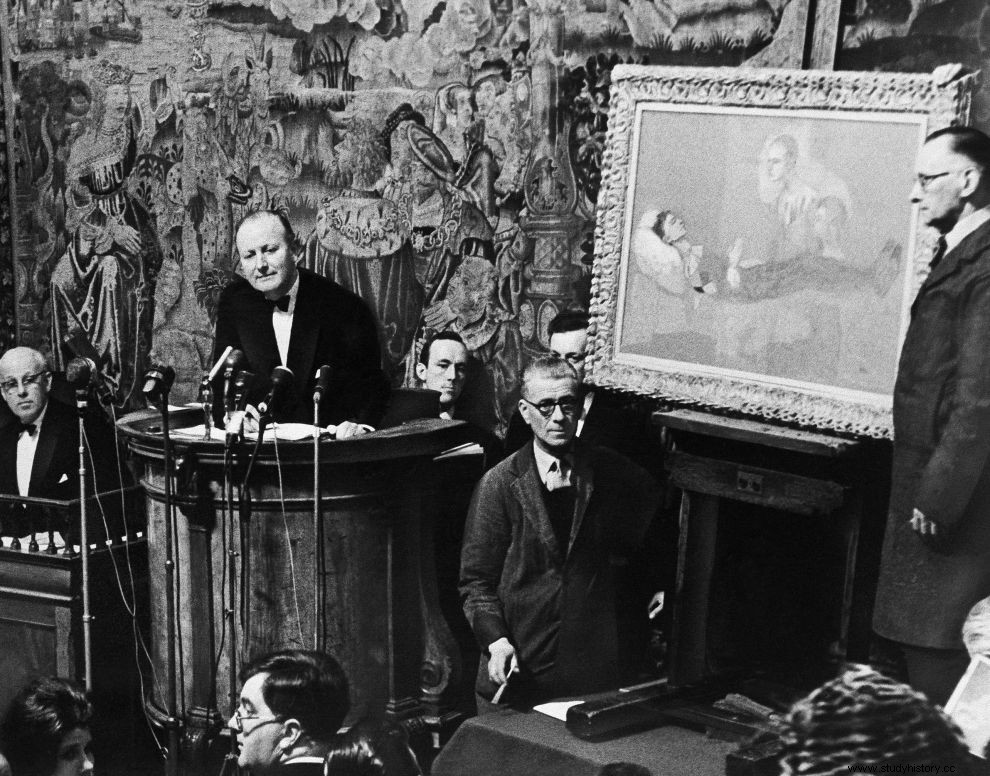
The colors became brighter and more earthy, while the bohemian, open and dynamic culture of Paris created cracks, through which a new painting "language" emerged, combining elements of intense lyricism and inner sensitivity on the canvas. The harlequins and the nudes of the pink period, are characteristic examples of a turn, at the beginning of which "idioms" from various trends (primitivism, classicism, impressionism) were adopted and assimilated. Through constant experimentation, a radically new painting aesthetic was finally formulated, which required continuous intellectual "processing", giving art an unparalleled eloquence of recreating the world of shapes.
In those early years in Montmartre, Picasso came into contact with the more progressive cultural milieu of the early 20th century, showing a clear preference for literary circles, rather than their respective painting ones. Friendships and relationships were built there that followed the Spaniard throughout his life. Guillaume Apollinaire , the poet who exerted the most profound and lasting influence on Picasso's artistic creation, Max Jacob, founder of surrealist poetry, the symbolist poets Louis Aragon, Paul Eliard and Jean Cocteau, all of them and many more, dedicated their works to "blue bird of Benin" (as Apollinaire called Pablo).
THE MISSES OF AVION (1907)

By the end of the 19th century, primitivism had come to the fore, an art movement that claimed to rediscover the simplicity of primitives. Arthur Rimbaud and Paul Gauguin, with different "tools" each, had explored the spirits of Africa and Oceania, to give life to their inspiration. Picasso admired African statues and in 1907 began the "adventure" of the "Misses of Avignon", one of the most important artistic stations of the 20th century. A painting influenced both by the art of the blacks and by that of the Iberians, in its pre-Roman period, which caused astonishment but also depression to the closest friends of the painter.
A work that seemed to dissolve all ties to Western painting (perspective illusion, mimicry and symmetry), subverting painting itself with the famous and scandalous "ugliness " of Picasso, the aesthetic "wildness" of the deconstructed female faces, which disturbed even the most progressive painters. Georges Braque, one of the founders of the Cubism movement along with Picasso, had stated about it:"It is as if someone had drunk gasoline and then play spitting fire". With this painting, the artist proclaimed a revolution, radically questioning the traditionally narrative function of painting, using distortion as representation.
PICASSO AND BRAQUE, THE ANALYTIC CUBISM
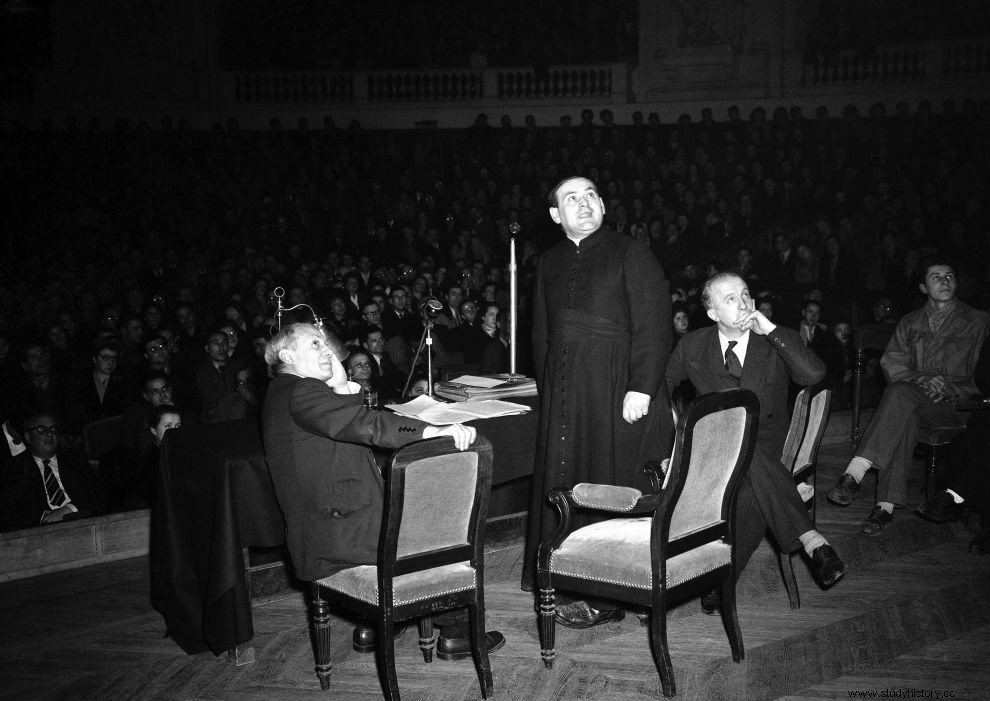
From the "Misses of Avignon" onwards, Picasso did not stop pioneering. Apollinaire was the one who introduced Braque to him in 1907 in Paris and that new friendship developed into one of the most productive in the history of art. The two painters focused on the work of Paul Cézanne, a pioneer of the transition from impressionism to cubism, and mainly on his most beloved motifs, landscape and still life. Flattening the image and splitting the object into multiple faces , created analytic cubism, a movement that was a real "explosion" in itself, leading to an autonomous and complex painting space.
Another historic phrase by Picasso, "I no longer see you when I look at you", sealed the fate of painting, completely removing it from imitation. The challenge, which had already begun with the obscene spectacle of the depiction of the five young ladies of an Avignon brothel, had culminated in no longer being able to detect anything obscene in the five "bathers" with their many angles and grimaces, placed in a "no space". What eventually happened during the analytic period of cubism was that the original cubes dissolved, having first understood the forms and contents. Thus, gradually, the objects ceased to be recognizable and the painting could no longer be "read".

Picasso and Braque replaced the illusionistic depiction and traditional "organization" of painting space with a new painterly idiom. They focused on questions related to the structure and volume of bodies, completely neglecting - at least initially - the question of color. They chose neutral shades of gray and brown, with the exact aim of "blocking" any distraction from the arrangement of the volumes and the space. Seeing, for example, Picasso's instrumentalists or still lifes of both, we realize that both wanted to explore the limits, push them further and take them to their most extreme "consequences".
In the period of analytic cubism, Picasso and Braque proceeded to fragment the outline of objects, to show their internal structure, i.e. lines, volume and individual colors. This practice was pushed to the point of total integration of the form into the space that surrounded it. This resulted in the figures being difficult to recognize if one looked at the painting closely, but they would "emerge" from the lack of depth as one slowly moved away from the work. A typical example is the "Portrait of Ambroise Vollard" ("Portrait de Ambroise Vollard") of 1910, where the "cubist" protagonist is not the human personality, but the organization of the painting.
SYNTHETIC CIVISM
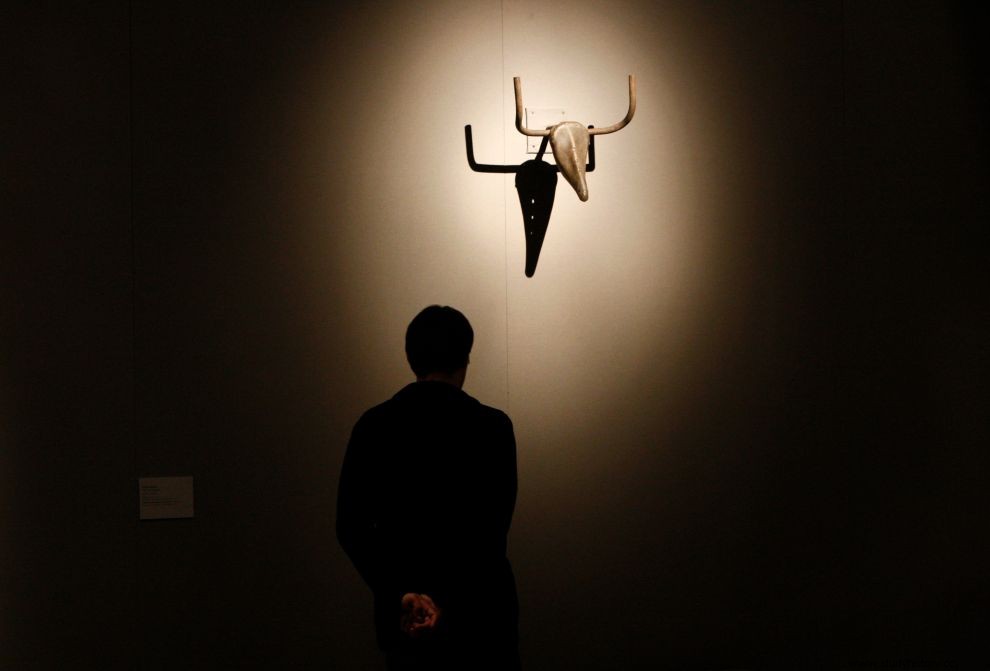
In May 1912, Picasso, with his "Still life in a straw chair" ("Nature morte à la chaise cannée"), gave the free shot to representational painting, moving to synthetic cubism. Starting from a general and abstract idea of the true painting element, the image was transformed into a composition of the basic symbols of the objects. The "vulgar" and bad taste material of the wicker chair was characterized as the ultimate sacrilege, plunging conventional depiction into despair. Picasso, with the phrase "I don't seek, I find", connected what was on the mat of the chair with tangible reality, adding a rope around the perimeter that performed the "debt" of the frame.
This is how the collage was born, the so-called "papiers collés " ("glued papers"), which marked the connection of cubism with color, developing sophisticated color nuances through humble materials:newspapers, wallpapers, musical scores, plywood, etc., which Braque developed to an even greater extent. The aim was "realistic", against analytical cubism which tended towards abstraction, and the result turned out to be liberating. Everything could now fit into a work of art. Collages were then "divided" into cubist, dadaist, futuristic or surrealist, depending on the structure them or their choice of material.
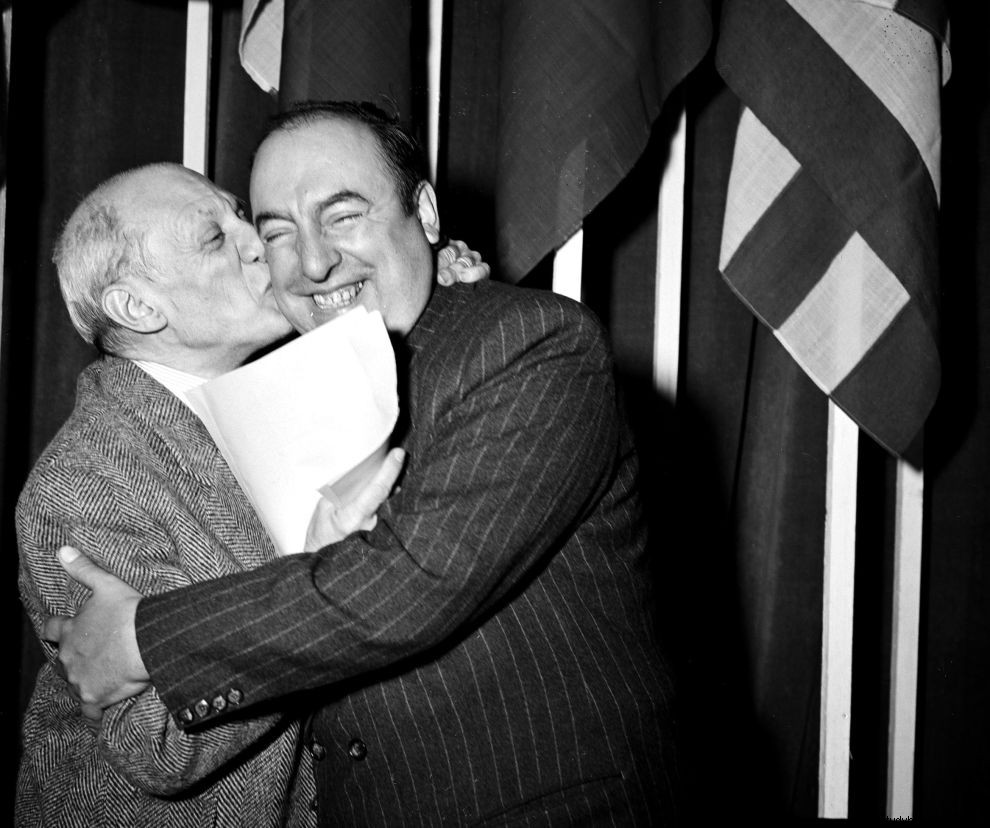
Synthetic cubism wanted to break with the difficulties of "reading" and the mixing of faces of the analytical period, presenting shapes and volumes on large levels, which was called the period of "crystal cynicism". Picasso, by inventing the collage, once again fundamentally reorganized the painting world. This technique, using - as we saw above - non-painting materials, in order to give life to relief images, essentially institutionalized the alternation of different artistic genres and their indiscriminate use. Picasso profoundly influenced in this way new avant-garde movements of modern art that arose in the middle of the 20th century.
The path between the collage and its "simulation" dictated the semantic and morphological reconstruction. Picasso abolished the two-dimensional nature of painting and abolished the borders between the plastic arts. In the paintings, the object was "divided" into conceptual levels:form, material, color . But cubism and stability were by no means compatible concepts, so instead of all this new technique developing into a distinct style, it was absorbed with different artistic practices by new forms, following separate paths. Aesthetic, formalist or ideological, figurative or abstract, collage "survived" precisely thanks to all these "tensions".
PLASTIC TRANSFORMATIONS

Constantly overturning the rules of painting creation, Picasso never stopped experimenting with new shapes and new techniques. In 1917 he "met" the theater, starting his collaboration with the Russian theater director Sergei Diaghilev. That year he created the costumes and sets for the ballet "Parade", with choreography by Leonid Masin, music by Eric Satie and a theatrical summary by Jean Cocteau. This was followed by the discovery of ceramics , which led him to try all kinds of recipes. Inspired by the shape of broken pieces or discarded objects, he combined the hollows of the vases with the curves of the human face and the female body.
Another pursuit that Picasso himself called "plastic metaphors", was the creation of objects that came from gathering and assembling various materials. These objects, although they had deviated from their original meaning and function, still retained the trace of the shape:forms for sweets, straw baskets, small model cars, handlebars from bicycles. All of this created structures that widened the field of traditionally recorded plastic forms, opening the way to a renewed and enriched idea of sculpture . Picasso's plastic transformations in ceramics and sculptures once again highlighted his bold personal style.

Pablo's perception that sculpture was a "void" pushed him to apply to it elements of analytical cubism. The decomposition of faces into concave and convex surfaces created plastic effects of great intensity. Engraving, another occupation in his career, was a new field of application, through which he never stopped experimenting and inventing new techniques. "Picasso is a man who always had the need to empty himself, to empty himself completely." With these words, Gertrude Stein (American writer, poet and art collector) described the most important characteristic of Picasso's personality, that is, his tendency to start again from scratch in order to free himself from his own stylistic clichés, constantly renewing the expression of of his imagination.
The human form has always been the main field of inquiry in Picasso's work. Searching for and extracting the lines from her, he ended up in a constant attempt to represent the woman. He listened to the female body, but sometimes rendered it cruelly, "abusing" its dynamic lines and sometimes with plastic images of intense eroticism. The first case, the realization in some way of the ideal of "brutal beauty", was considered by the surrealists as a creative and aesthetic model. Picasso indeed approached in some way the "idiom" of surrealism, but without being particularly influenced by it.
PICASSO'S BULL

From the late 1920s, a new subject appeared in Picasso's mythological world from which he drew inspiration:the Minotaur. Like the Harlequin, the Minotaur was a symbolic transformation of the artist and his ambiguous creative power. He was both creator and destroyer. "For me a painting is a set of disasters, first I create it and then I destroy it. But in the end nothing is lost, the red I took out of one place, I will put it elsewhere", he said in 1935 to Christian Zervos (art historian , publisher, art collector and scholar of primitivism).
In Picasso's works, the presence of the "Minotaur" was more associated with bullfights . The bull was the cult carcass, destined to be in constant confrontation with death, symbolizing the drama of life and the creative tension, constantly balanced between success, defeat and death. The destructive instincts of the bull were combined with the skillful movements of the bullfighter, but the roles were reversed:the animal was the victim and the man the aggressor. Blood was the price one had to pay to gain access to the myth. Thus, the Minotaur essentially externalized the dark and primitive sides of everyone.
GUERNIKA (1937)
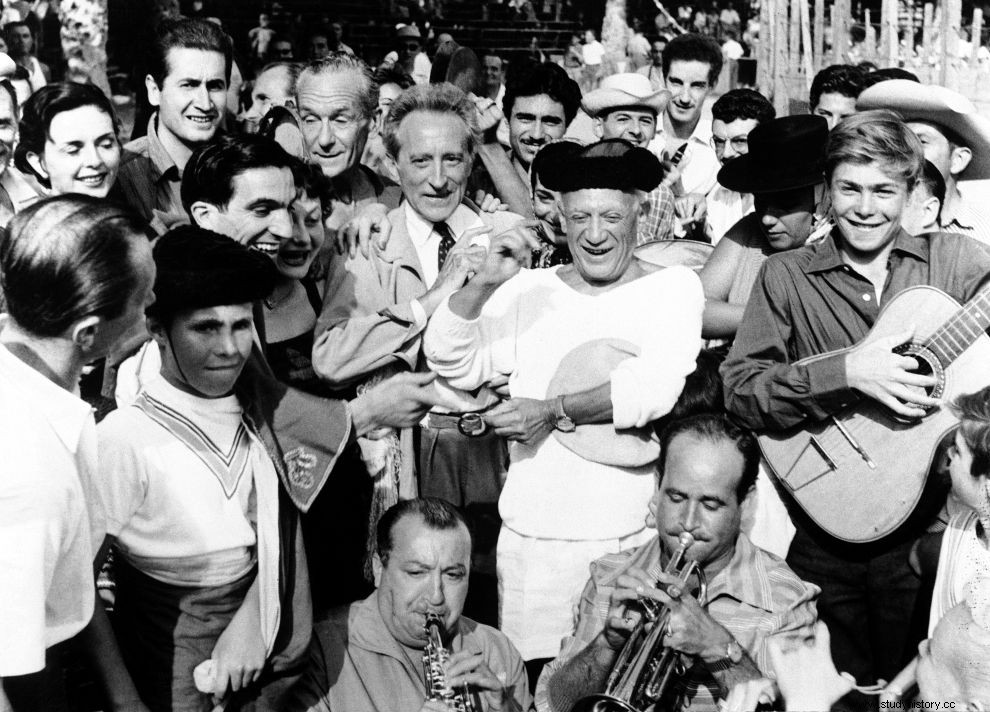
The civil war in Spain started in 1936 and ended in 1939. On April 26, 1937, Göring's German air force leveled the small town of Guernica in the Basque Country for the sake of Franco. The hundreds of dead from that horrific bombing would soon have passed into the oblivion of history, if Picasso had not taken care to collect some of the mutilated bodies lying on the streets of the Basque town and turn them into an eternal symbol of the rebellion against fascism , on those 3.5 by 7.7 meters of canvas, where one of the most chilling anti-war cries in history was captured. All this with lines and forms in their most symbolic aesthetics.
"Guernica", radical and violent, sealed the fate of the rebellion with a scream so loud, it made you hold your breath when you stood in front of it. Ανέτρεψε κάθε συμβατικό μοτίβο μετατρέποντας τον χρόνο σε βουβή οργή. Ήταν η στρατευμένη τέχνη στην πλήρη της αλήθεια. Μια αλήθεια που πήγασε μέσα από τη "φρίκη" των γεωμετρικών αποχρώσεων του γκρίζου, που με τη σειρά τους πλαισιώθηκαν από την ένταση του μαύρου και του άσπρου. Μέσα στον καμβά, συμπυκνώθηκαν όλα όσα χρειάζονταν για να αποδοθούν σε μια μη αναστρέψιμη πραγματικότητα, τα όρια και ό,τι βρισκόταν πέρα από αυτά:η τραγωδία, ο θρήνος, ο θάνατος, οι κραυγές, η απελπισία, ο πόλεμος.
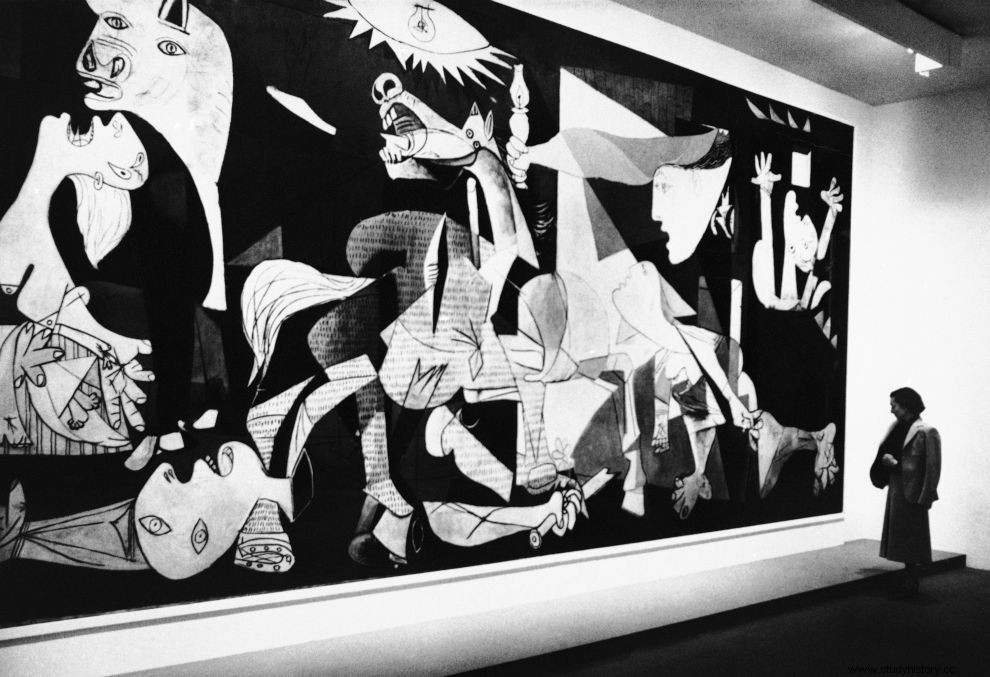
Οι μορφές του αλόγου, του πολεμιστή και του ταύρου, στοιχειωμένες από τη βαρβαρότητα και το σκοτάδι, "περιέγραψαν" την ίδια την καταστροφή χωρίς έλεος. Η μάνα με γλώσσα στιλέτο και μάτια δάκρυα, κρατώντας στα χέρια το νεκρό της, χωρίς κόρες, παιδί, σε μια "Πιετά" που ξέσκιζε κάθε ψυχή και αιμορραγούσε το τέρας του πολέμου. Η παραστατικότητα του Πικάσο ήταν τόσο παραμορφωμένη, σαν παγιδευμένη αρπαγή και φθορά μέσα στην πλήρη ερήμωση. Ο κυβισμός του ζωγράφου υπηρέτησε αυτό ακριβώς που θέλησε να αποδώσει. Διαμελισμένες μορφές, αιχμηρές γραμμές, ξεχειλωμένα σχήματα και μια σαφέστατη πρόθεση αναδημιουργίας της ίδιας της σκληρότητας που χρειάστηκε να "επινοήσει" για να "φτύσει" στα μούτρα τους δολοφόνους φασίστες.
Η "Γκερνίκα"υπήρξε ένα κάδρο επανάστασης που μετέτρεψε την ίδια την αισθητική του σε πολιτικό μανιφέστο , σε σύμβολο εξέγερσης, σε στιγμιότυπο αφορισμού και αντέστρεψε το αποτέλεσμα, "καταδιώκοντας" πλέον όλους εκείνους που έκαναν την κωμόπολη έναν τεράστιο λάκκο γεμάτο πτώματα. Τη δύναμη της "Γκερνίκα", αυτό το βουβό δράμα που βγαίνει μέσα από τα σωθικά της, ίσως να το έχει περιγράψει καλύτερα απ' όλους, ο Γάλλος σουρεαλιστής συγγραφέας Μισέλ Λεϊρίς, όταν πρωτοαντίκρισε μπροστά του τον πίνακα το 1937:"Είναι περιττό το να επιχειρήσει κανείς να βρει τις λέξεις για να περιγράψει αυτή την επιτομή της καταστροφής σε άσπρο και μαύρο... Ο Πικάσο μάς στέλνει ένα αγγελτήριο κηδείας. Ό,τι αγαπάμε, πεθαίνει..."
ΤΟ ΚΑΤΑΦΥΓΙΟ ΣΤΗ ΜΕΣΟΓΕΙΟ
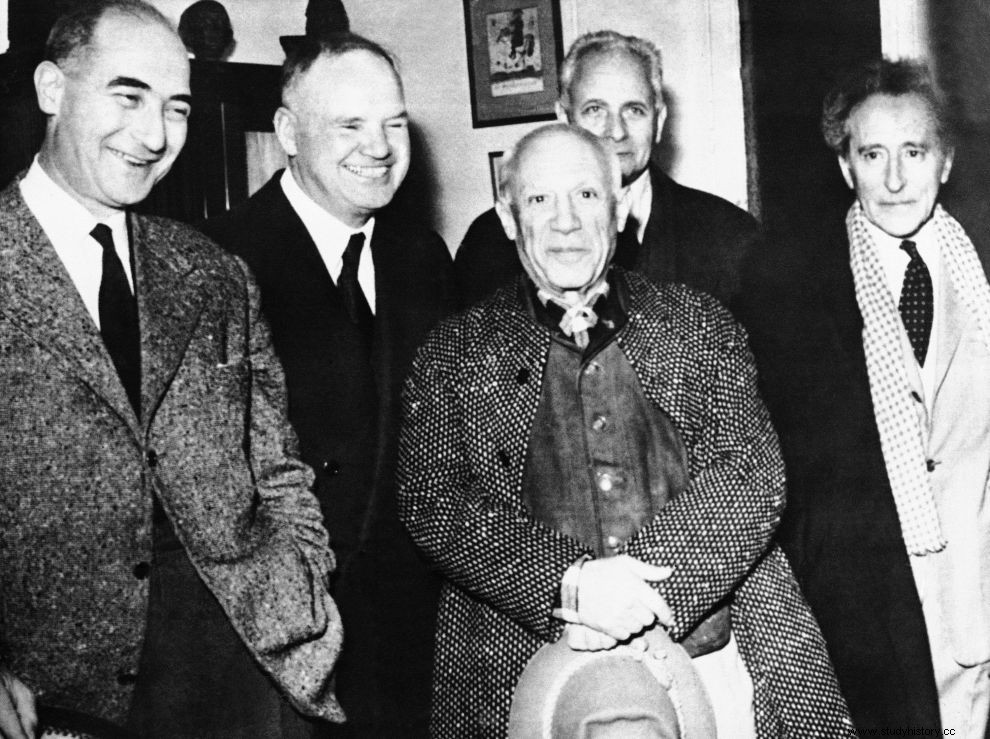
Το έργο του Πικάσο μετά το τέλος του Β' Παγκοσμίου Πολέμου, υπήρξε πολυεπίπεδο και χαρακτηρίστηκε από πολύ έντονη δημιουργική δραστηριότητα. Ο καλλιτέχνης επέστρεψε στα αγαπημένα του θέματα:ταυρομαχίες, σκηνές από την καθημερινότητα, πρόσωπα και μορφές από την οικογένειά του, καθώς και εκ νέου ερμηνεία της ζωγραφικής των δασκάλων του παρελθόντος, από τον Ρέμπραντ ως τον Νταβίντ, από τον Βελάθκεθ ως τον Ντελακρουά και από τον Ελ Γκρέκο ως τον Μανέ. Σε αυτά τα χρόνια εντάθηκε και η σχέση του με την πολιτική. Το 1944 έγινε μέλος του Γαλλικού Κομμουνιστικού Κόμματος (ΓΚΚ) και υπήρξε ενεργός σε διάφορα μέτωπα, όπως η τοποθέτησή του ενάντια στον πόλεμο στην Κορέα και το διάβημά του ενάντια στη σοβιετική εισβολή στην Ουγγαρία (1956).
Ο Πικάσο ήταν πάντα ένα ανεξάρτητο πνεύμα και οι σχέσεις του με το ΓΚΚ υπήρξαν διαχρονικά ταραχώδεις, χωρίς όμως να διαγραφεί ποτέ από αυτό. Πάντως δεν έχανε ευκαιρία να παίρνει θέση για ζητήματα που αφορούσαν τον πόλεμο μέσα από πίνακές του, ενώ ο ίδιος είχε δηλώσει πως "η ζωγραφική δε δημιουργήθηκε για να διακοσμεί διαμερίσματα, αλλά για να αποτελεί ένα όπλο ενάντια στον εχθρό". Μαζί με άλλους διανοούμενους, στήριξε τον Νίκο Μπελογιάννη , στον οποίο αφιέρωσε το διάσημο σκίτσο, ανοιχτό στην άκρη, με τίτλο "ο άνθρωπος με το γαρύφαλλο". Όταν τον ρώτησαν γιατί δεν το έκλεισε, εκείνος απάντησε:"Έναν τόσο μεγάλο άνθρωπο δεν μπορείς να τον κλείσεις σε ένα πορτραίτο".

Το 1955 γυρίστηκε από τον Ζορζ Κλουζό η ταινία "Το μυστήριο Πικάσο", αποκαλύπτοντας την καταπληκτική "ταχύτητα" της διαδρομής του καλλιτέχνη, στις διαρκείς μεταμορφώσεις της ζωγραφικής και στις νέες αναδομήσεις που συνεχώς προέκυπταν μέσα από τα έργα του. Τα ατελείωτα εκφραστικά μέσα που χρησιμοποίησε, μας χάρισαν κάθε φορά μια αποκάλυψη και συγχρόνως ένα αίνιγμα. Το "ψηφιδωτό" της ανεξάντλητης δημιουργικής του παλέτας, σχηματίστηκε από ψηφίδες στιλιστικών πειραμάτων που απέρριψαν κάθε πιθανό κομφορμισμό. Τα χρόνια της Μεσογείου, με τα "καταφύγια" της Προβηγκίας και της Κυανής Ακτής , έδωσαν στον Πικάσο την ευκαιρία να κατακτήσει τα έργα του, να τα "κατοικήσει", κινούμενος σε ένα "ανοιχτό πεδίο", μακριά από οποιοδήποτε "πλαίσιο".
Σήμερα, 140 χρόνια μετά τη γέννησή του, μπορούμε να πούμε με σιγουριά ότι η προσφορά του στη διαμόρφωση της σύγχρονης τέχνης ήταν τέτοια, που πρέπει να ικανοποίησε τη δημιουργική του υπερηφάνεια. Σφράγισε τη μοίρα της ζωγραφικής, απάντησε σε όλες τις προκλήσεις, παρουσίασε νέα εργαλεία της ανησυχίας και του πάθους, υπηρέτησε αισθητικούς και ιδεολογικούς στόχους, υπογράμμισε διαστάσεις γραμμών και εννοιών, δόμησε και αποδόμησε τον καλλιτεχνικό γαλαξία του 20ου αιώνα με φόρμες, ιδιώματα και τεχνικές, ξεγύμνωσε την ίδια την "πραγματικότητα" συναρμολογώντας την από την αρχή. Ο Πάμπλο Πικάσο τελικά, ώθησε πιο μακριά τα σύνορα της τέχνης, τα σύνορα του κόσμου.
* Πηγές:pablopicasso.org, pablopicasso.net, Picasso-Electa, Larousse Le Siécle Rebelle, wikiart.org, wiki, moma.org, theguardian.com
